National Perceptions - Propaganda Posters
Introduction
Text-to-speech Audio
The National Archives and Records Administration (NARA) provides public access to thousands of national historic records throughout the country. The NARA research room in College Park, Maryland, serves as a physical location for the public to observe records and other historic materials. Records are also widely available online for those who cannot travel to physical NARA headquarters throughout the United States.
"Throughout the twentieth century...propaganda has been one of the crucial tools of warfare and has been enlisted to manipulate the ideas, attitudes, conclusions, and tolerance levels of civilians and soldiers" (Finch 370).
Government Propaganda is a major proponent during any war, and World War II was no exception. On top of other media methods, the United States government released numerous propaganda posters to encourage the American public to support war efforts and rally against common enemies. Unfortunately, such propaganda became a way to promote racist stereotypes against Japan and the Japanese. Both caricatures of the Japanese as well as depictions of the Japanese as animals gained traction in propaganda posters throughout 1942 to 1945. As historian John Dower explained, the United States framed the Japanese as an “other” during World War II, offering that:
"the Western allies...persisted in their notion of the ‘subhuman’ nature of the Japanese, routinely turning to images of apes and vermin to convey this" (Dower 9).
Images
U.S. Navy Propaganda Poster describing the Japanese enemy
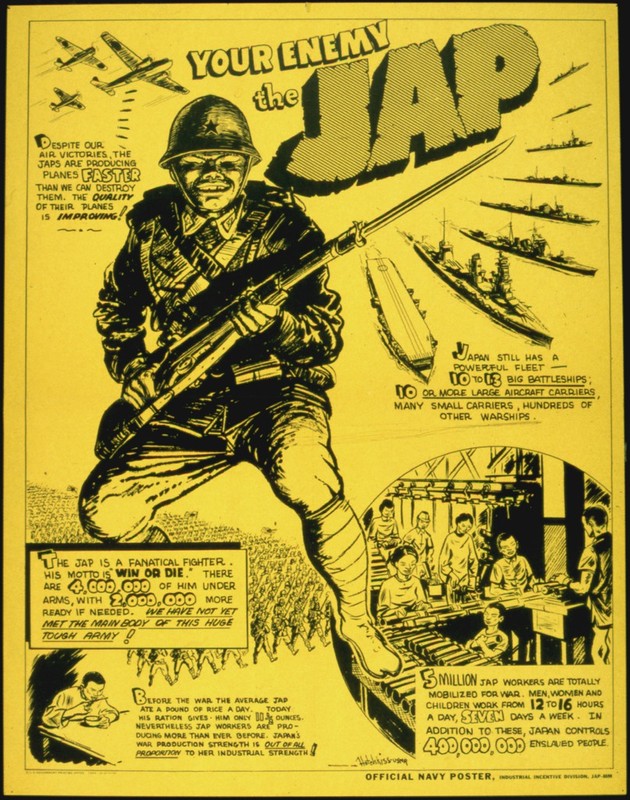
"Jap Trap" - U.S. Propaganda Poster
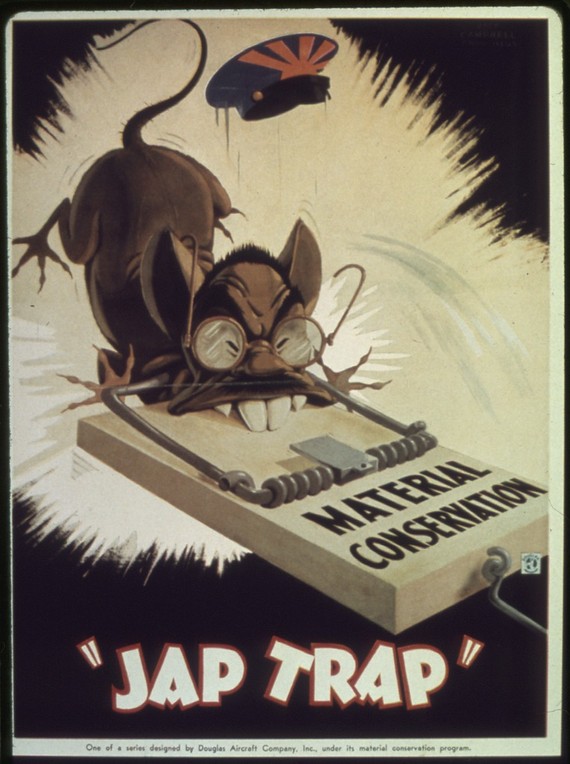
"Tokio Kid Say" - US Propaganda Poster
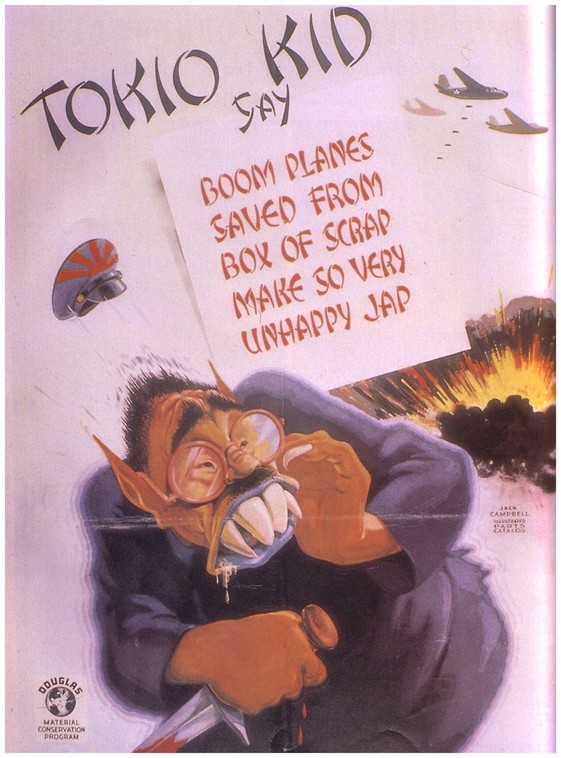
"The Little Jap is a Big Job!" - U.S. Propaganda Poster
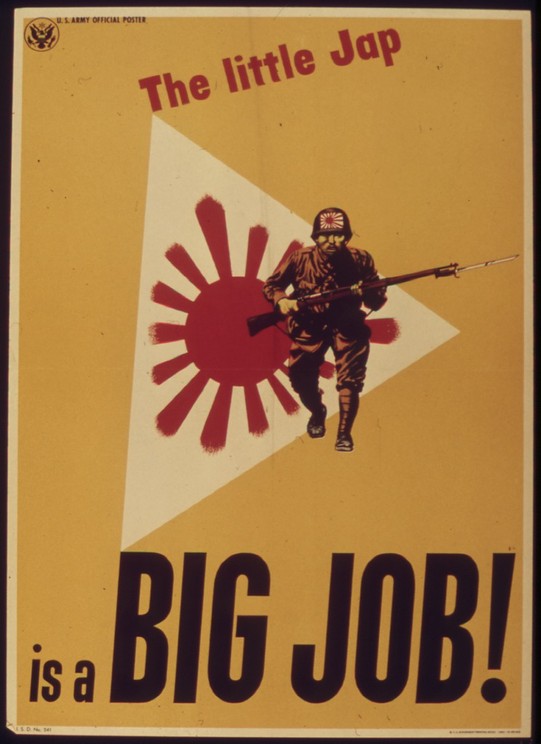
"Put the Squeeze on the Japanese" - U.S. Propaganda Poster
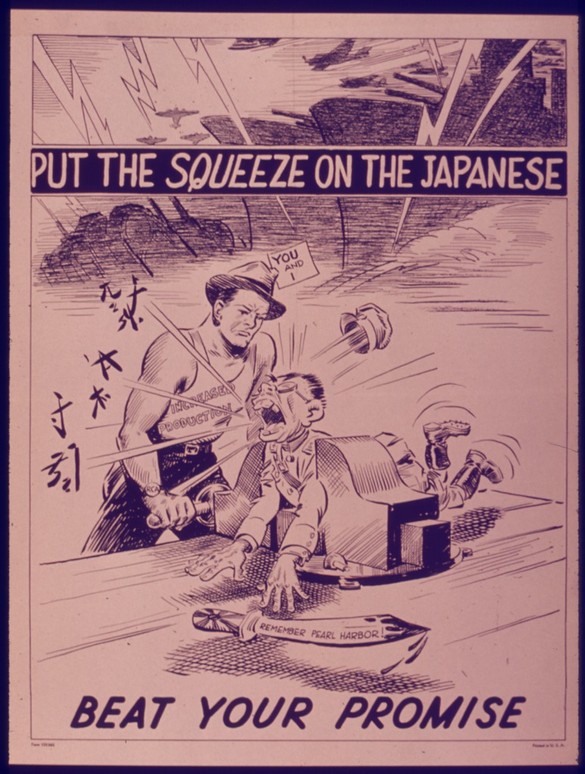
Backstory and Context
Text-to-speech Audio
As Asian studies specialist Christina Klein offers:
"propagandists in Washington and Hollywood depicted the Japanese as a faceless mass of subhuman enemies worthy of extermination" (Klein 4).
With the American populace wary of a second Japanese attack, the government utilized propaganda as a tool to channel American fear into the war effort, especially encouraging support in the fight against Japan.
Depictions of the Japanese threat included animalistic symbols and stereotypical Japanese caricatures. While propaganda was originally intended to target the Japanese in Japan, it did have a negative impact on Japanese Americans and Japanese immigrants in the United States. As historian Roger Daniels explains:
"Japanese America was simply destroyed, although some of the pieces would be put back together after the war" (Daniels 187).
A collective suspicion of the Japanese, and the belief that Japanese Americans would be loyal to Japan rather than the United States, permeated public opinion, a reflection of similar fears from the early 1900s after the Russo-Japanese War (Kurashige 87). The lasting impression of assimilation to American society and propositions that specific groups could not assimilate over time also played a factor in such mindsets. Even President Franklin D. Roosevelt, like his distant cousin Theodore before him, did not believe that the Japanese could assimilate with white Americans (Kurashige 170).
Justification of actions against the Japanese in Japan, as well as Japanese Americans in the U.S., were influenced by the continued portrayal of Japan as a nation of subhuman people who would remain loyal to the emperor. As historian Brandon Seto states:
"In publications and in the popular consciousness of the people who read them, the Japanese could exist as malicious subhuman creatures bent on the destruction of the American nation itself" (Seto 60).
Propaganda is a powerful wartime weapon, allowing specific thoughts and principles to permeate a nation's people and influence their attitudes (Finch 370). It is apparent that the United States government capitalized on propaganda and successfully used it to influence the American people to support war efforts and identify the Japanese as an enemy in need of destruction.
Sources
Daniels, Roger. Asian America: Chinese and Japanese in the United States Since 1850. [N.p.]: University of Washington Press, 2011.
Dower, John W. War without Mercy: Race and Power in the Pacific War. Pantheon Books, 1986.
Finch, Lynette. “Psychological Propaganda: The War of Ideas on Ideas During the First Half of the Twentieth Century.” Armed Forces & Society 26, no. 3 (Spring 2000): 367–86. doi:10.1177/0095327X0002600302.
Horten, Gerd. Radio Goes to War: The Cultural Politics of Propaganda during World War II. University of California Press, 2002.
Klein, Christina. Cold War Orientalism: Asia in the Middlebrow Imagination, 1945-1961. Berkeley: University of California Press, 2003.
Kurashige, Lon. Two Faces of Exclusion: The Untold History of Anti-Asian Racism in the United States. Chapel Hill: The University of North Carolina Press, 2016.
National Archives and Records Administration Collection; ddr-densho-37; 1940s; Courtesy of National Archives and Records Administration; Densho Digital Repository; https://ddr.densho.org/ddr-densho-37/.
Seto, Brandon P. “Paternalism and Peril: Shifting U.S. Racial Perceptions of the Japanese and Chinese Peoples from World War II to the Early Cold War.” Asia Pacific Perspectives 13, no. 1 (2015): 57–78.
World War II Posters, 1942-1945; Office for Emergency Management. Office of War Information. Domestic Operations Branch. Bureau of Special Services, Record Group 44; National Archives and Records Administration – College Park Region (Maryland). https://catalog.archives.gov/id/513498.
"Your Enemy the Jap," Densho Digital Repository, ID#: ddr-densho-37-499, Parent Collection: National Archives and Records Administration Collection, https://ddr.densho.org/ddr-densho-37-499/
"Jap Trap," Densho Digital Repository, ID#: ddr-densho-37-498, Parent Collection: National Archives and Records Administration Collection, https://ddr.densho.org/ddr-densho-37-498/
"Tokio Kid Said," Densho Digital Repository, ID#: ddr-densho-37-653, Parent Collection: National Archives and Records Administration Collection, https://ddr.densho.org/ddr-densho-37-653/
"The Little Jap is a Big Job!," Densho Digital Repository, ID#: ddr-densho-37-497, Parent Collection: National Archives and Records Administration Collection, https://ddr.densho.org/ddr-densho-37-497/
"Put the Squeeze on the Japanese," Densho Digital Repository, ID#: ddr-densho-37-488, Parent Collection: National Archives and Records Administration Collection, https://ddr.densho.org/ddr-densho-37-488/
